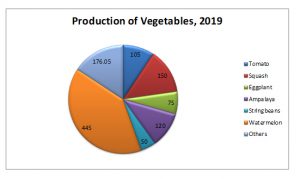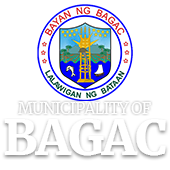Industries
Bagac’s major economic industries are farming and fishing. All its rural barangays including one urban barangay namely Barangay Pag-asa are engaged in these economic activities. With vast lands for agriculture and long coastline, almost half (48.17%) of Bagac’s total household of 8,047, considered farming and fishing as their primary source of livelihood.
Of the total land area of Bagac, around 12.26 square kilometers (5.30%) are being utilized for agricultural activities. Of the total agricultural land, 53 percent is used for fruit production. This includes mango, banana and coconut, among others. About 43 percent is utilized for grains such as rice and corn. Both root crop production and vegetable production have utilized two percent each.

Like any other municipality within Central Luzon, Bagac also produces rice and corn. On an average, the Municipality produced 10,692 MT of rice and 100 MT of corn every year.
Production of Grains, 2019
| Grains | Total Production (in MT) |
|---|---|
| 1. Rice | 10,692 |
| 2. Corn | 100 |
Different varieties of vegetables are grown in Bagac. In 2019, watermelon was the widely produced vegetable in the Municipality with a production of 445 MT.

Production of Vegetables, 2019
| Vegetable | Total Production (in MT) |
|---|---|
| Tomato | 105 |
| Squash | 150 |
| Eggplant | 75 |
| Ampalaya | 120 |
| Stringbeans | 50 |
| Watermelon | 445 |
| Others | 176.05 |
Fruits such as mango, banana and coconut are also widely raised in Bagac. In 2019, coconut was the most harvested fruit in Bagac with 3,000 MT. Other fruits that are also grown in Bagac are Banana, Mango, Cashew, Citrus, Tomato, and Watermelon.

Production of Fruits, 2019
| Fruits | Total Production (in MT) |
|---|---|
| Mango | 1,103 |
| Banana | 2,900 |
| Coconut | 3,000 |
| Cashew | 1,981 |
| Citrus | 50 |
Farmers also produced some root crops. The largest produced root crop in the Municipality is Cassava with 140 MT. Other root crops produced in the Municipality are sweet potato and peanuts.
Production of Root Crops, 2019
| Root Crops | Total Production (in MT) |
|---|---|
| 1. Cassava | 140 |
| 2. Sweet Potato | 4000 |
| 3. Peanut | 40 |
With about 28-kilometer shoreline covering the tip of Municipal coastal boundaries, Bagac’s other main source of income especially in the coastal barangays – Binuangan, Quinawan, Paysawan, Pag-asa, Saysain and Banawang is fishing. In 2019, the Municipality has recorded an estimated catch of 1,851.77 MT. Of this figure, 96 percent was caught using motorized banca while the remaining 4 percent was caught using non-motorized banca.
There are five (5) identified fishing grounds in the Municipality. These are the only areas wherein fishing is allowed.
Area and Length of Coastline of the Designated Fishing Grounds
| Fishing Ground | Barangays | Area (in square kilometer) | Length of Coastline (in kilometer) |
|---|---|---|---|
| 1. Looc Bay | Banawang | 45 | 6 |
| 2. Bagac Bay | Pag-asa, Saysain | 120 | 8 |
| 3. Paysawan Bay | Paysawan | 30 | 4 |
| 4. Binuangan Bay | Binuangan | 30 | 4 |
| 5. Quinawan Bay | Quinawan | 75 | 6 |
The most commonly caught fish from the fishing banks of the Municipal waters are alumahan, talakitok, lapu-lapu, sapsap and bonito. Substantial amount of igat, dalag, hipong-ilog, and biya are caught in the rivers.
Employment on Fishing, Average Catch and Number of Boats, 2019
| Barangays | Number of Fishermen | Average Catch per Day (in kilograms) | Number of Boats | ||
|---|---|---|---|---|---|
| PEAK | LEAN | Motorized | Non-Motorized | ||
| 1. Pag-asa | 480 | 30 | 10 | 163 | 23 |
| 2. Saysain | 251 | 30 | 10 | 39 | 20 |
| 3. Binuangan | 70 | 28 | 10 | 22 | 8 |
| 4. Quinawan | 160 | 30 | 10 | 40 | 4 |
| 5. Paysawan | 79 | 28 | 8 | 16 | 3 |
| 6. Banawang | 69 | 21 | 5 | 38 | 2 |
| 7. Ibis | 7 | 1 | 4 | ||
| 8. A. Ricardo | 6 | 1 | |||
| 9. Tabing-Ilog | 6 | 4 | |||
| 10. Ibaba | 21 | 1 | 1 | ||
| 11. Bagumbayan | 3 | 1 | |||
| TOTAL | 1,152 | 167 | 53 | 325 | 66 |
There are six barangays that are engaged in fishing. These are the barangays of Pag-Asa, Saysain, Binuangan, Quinawan, Paysawan, and Banawang. Moreover, barangays that have an extensive connection to rivers are into small scale fishing. These are the barangays of Ibis, Ibaba, and Tabing- Ilog.
The forest resources of Bagac which cover about 12,000 hectares are part of the Bataan National Forest Reserve. It is primarily second-growth forests with patches of open grassland, brushlands, and cultivated areas.
About 24.9 square kilometers are used in Forestry. This is classified as production and protection forests. Of the total land area, 76.06 percent is zoned as production forest divided into timber production, grazing land, and community based forest management. The remaining 23.94 percent is entirely for protection forest declared as part of the National Integrated Protected Areas System (NIPAS), which include the Bataan Natural Park located at the northernmost part of the Municipality.
Households in Bagac are practicing backyard livestock and poultry raising. In 2019, chickens are widely raised in Bagac with about 500,000 heads. Chicken production and processing are done in the factory center in Barangay San Antonio. This poultry farm serves as a breeding station and manufacturing of poultry products such as eggs and chickens.
In terms of livestock, pigs, cattles, carabaos, horses and goats are the most commonly raised animals. Most of the productions are from Barangay Ibis and Parang.

